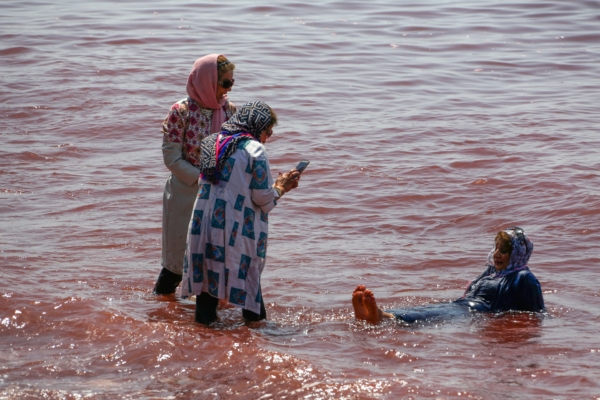A viral video circulating online shows a heavy rainstorm occurring on Hormuz Island in the Persian Gulf, turning the beach and sea waters into a striking shade of red. Numerous visitors eagerly gathered in the rain to witness and capture this unusual spectacle.
Instagram user hormoz_omid shared a video in February showcasing the rainfall on Hormuz Island that dyed the beach and ocean waters red. The post has garnered nearly one million likes to date.
In the footage, pouring rain can be seen from the sky as several tourists stand watching and filming in the rain. The heavy rainfall washed over the red-colored soil, flowing downhill from the hills and dyeing the beach and sea waters red.
hormoz_omid captioned the post: “Today, Red Beach saw heavy rainfall. High tide and tourists showed up.”
Despite some online users finding the sight awe-inspiring, others voiced concerns like, “The sea turning red, rumors of war… could this be the last generation on our planet plagued by devastation? Who knows?”
This natural phenomenon is attributed to the mineral-rich coastline of Hormuz Island. The high concentration of iron oxide in its soil mixes with the seawater, altering the color of the beach and creating vivid red waves.
The Iran Tourism and Touring Organization highlights on its website that Hormuz Island boasts a mountain rich in red oxide earth. This type of soil is not only a valuable industrial mineral but also used locally as a spice in cooking, such as in sauces and jams.
The mountain overlooks the coast, offering a unique view of the red beach and waves that are unmissable. Moreover, walking along the coastline reveals glittering metallic compounds in the sand, particularly enchanting during sunrise or sunset.
The red soil of Hormuz Island holds significant economic value, used in various industries like dyes, cosmetics, glass, and ceramics, and has been exported to other countries for many years. However, with the gradual loss of this distinctive soil, exports have become more limited.
Exploring Hormuz Island, one notices the constantly changing colors of the surrounding soil, as the island hosts over 70 types of colorful minerals, earning it the moniker “rainbow island.”
The British Broadcasting Corporation (BBC) previously reported that Kathryn Goodenough, a chief geologist at the British Geological Survey who had worked in Iran, explained that hundreds of millions of years ago, shallow seas at the edge of the Persian Gulf formed thick salt layers. Over time, these layers interacted with volcanic sediments rich in minerals, resulting in the colorful terrestrial formations.
Goodenough stated, “Over the last 500 million years, the salt layers have been deeply buried by younger volcanic deposits. With salt being buoyant, it rises through fractures in the overlying rocks and forms salt domes on the surface.”
She added, “These thick salt layers are located several kilometers beneath the surface and essentially cover most parts of the Persian Gulf.”
Despite the island’s captivating array of natural hues, most tourists remain unaware of its geological wonders. According to the Ports and Maritime Organization of Iran, only 18,000 tourists visited the island in 2019.
Local resident Ershad Shan believes that although Hormuz Island holds significant historical and natural treasures, tourists from around the world have yet to fully discover its uniqueness.
He expressed, “With greater attention from authorities towards developing the infrastructure of Hormuz Island, it could become a key tourist destination.”

